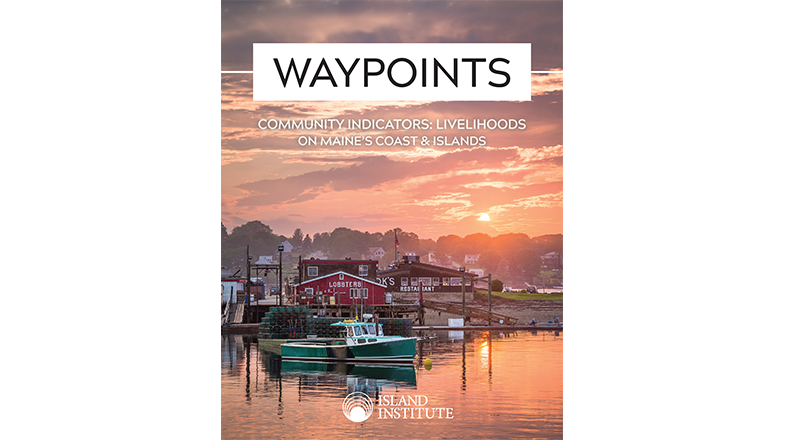ROCKLAND, ME – The Island Institute has published Waypoints: Livelihoods on Maine’s Coast and Islands featuring a first-time look at a range of coastal community employment indicators. The report presents visualized data and stories about how residents make a living and how Maine’s coastal and island communities compare to the rest of the state and the nation. It is a resource for local community and municipal leaders, state and federal representatives, agency staff, and research partners who are seeking to better understand the complex factors shaping the coastal Maine workforce.
Highlights of the findings include the following:
- A tale of two coasts: Population size, income levels, and industries distinguish the greater Portland area and southern Maine from the Midcoast and Downeast regions. For example: two-thirds of coastal residents live in the Portland area and southern coast, and smaller communities are more dependent on resource-extraction jobs.
- Employment defines the local character of the coast: Industry sectors distinguish the character of our communities. In some communities, lobstering leads; in others, retail, arts, and tourism distinguish the culture.
- Life on a fixed income: Almost 40% of island and coastal residents rely on Social Security income, compared to 30% nationally.
- Self-employment and seasonality: Economic activity along the coast is distinguished by a self-employed, highly seasonal workforce. About 45% of coastal and island residents work seasonally, 10% more than the U.S. average. And 38% of year-round islanders are self-employed, more than three times the national average.

The featured indicators in this infographic-rich publication include: population distribution and age; employment by industry; income and affordability; business ownership; labor force and seasonality; self-employment; the economic impact of the lobster fishery; age and education; and gender in the workforce.
For example: a look at gender demographics along the coast reveals there is a large divide between the median earnings of women and men in the highest-income communities with income for men reaching $44,000/year, almost double that for women at $26,000/year. The gap is somewhat smaller in lower-income communities.

“In Waypoints: Livelihoods, we go beyond the headlines about our state’s economy to share never-before combined data to tell an in-depth story of how Mainers along the coast work to turn incomes into living. This piece is a must-read for anyone working to shape the future of our coast,” said Suzanne MacDonald, Senior Community Development Officer at the Island Institute.
Data in this publication has been aggregated and analyzed by the research team at the Island Institute and articulated through maps and infographics illustrating the unique qualities of Maine’s coastal and island communities. The data illustrates how the size of communities impacts the ability of coastal residents to make a living. Additionally, detailed data on each of the 120 island and coastal communities is available online in the supplementary data tables allowing users to access information for each town.
As the future of the Maine economy is shaped, the Island Institute aims to highlight the significance of the Maine coast through objective, reliable information and is committed to tracking these data over time to show trends through 2025. The findings in this publication will be featured and discussed with panelists during the third annual Waypoints Forum, convening Friday, February 8, 2019 at the Westin Harborview in Portland.
The Waypoints publication, along with its supporting datasets, is available online at: www.islandinstitute/waypoints


